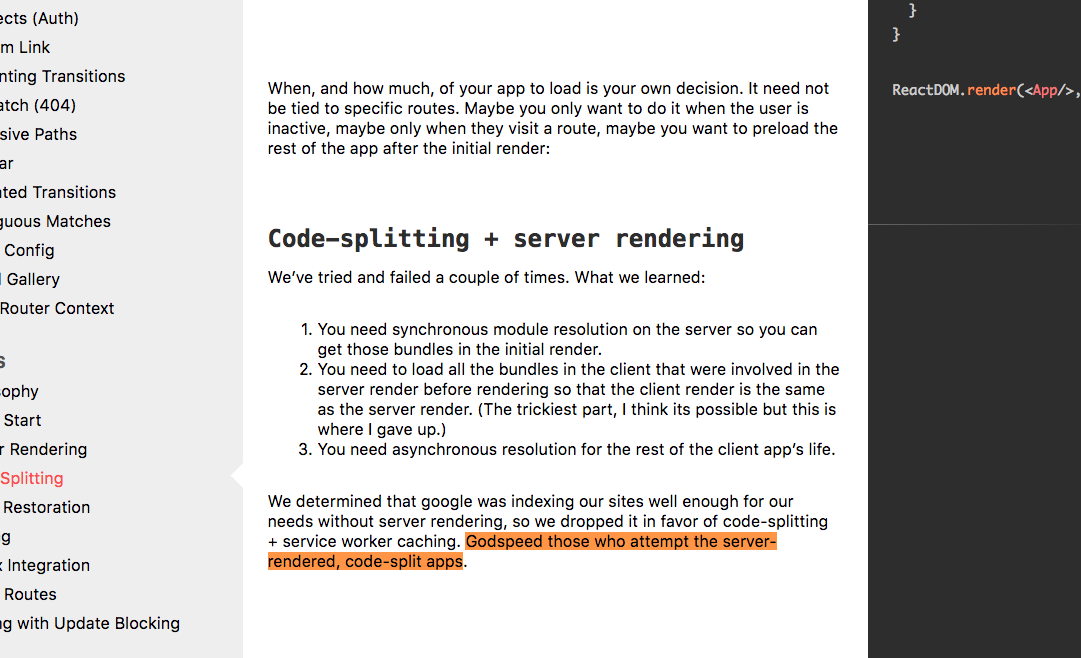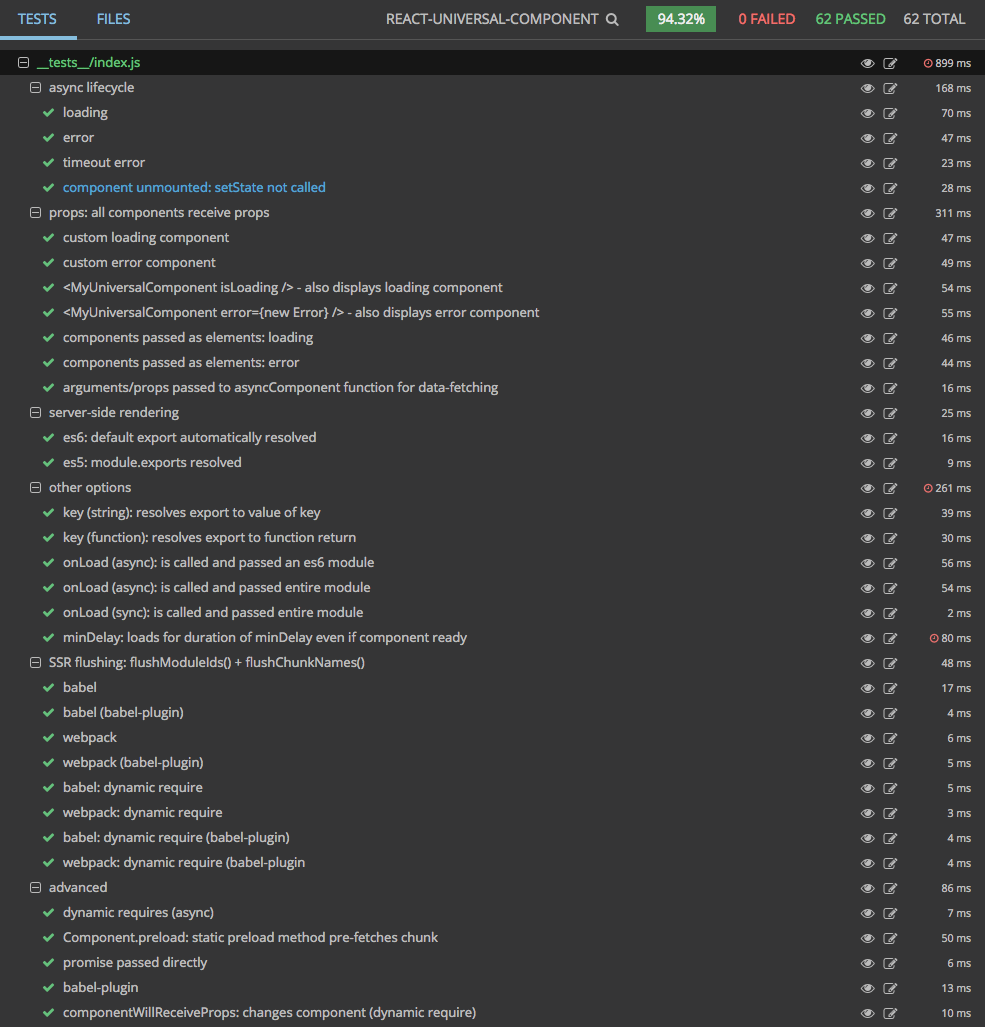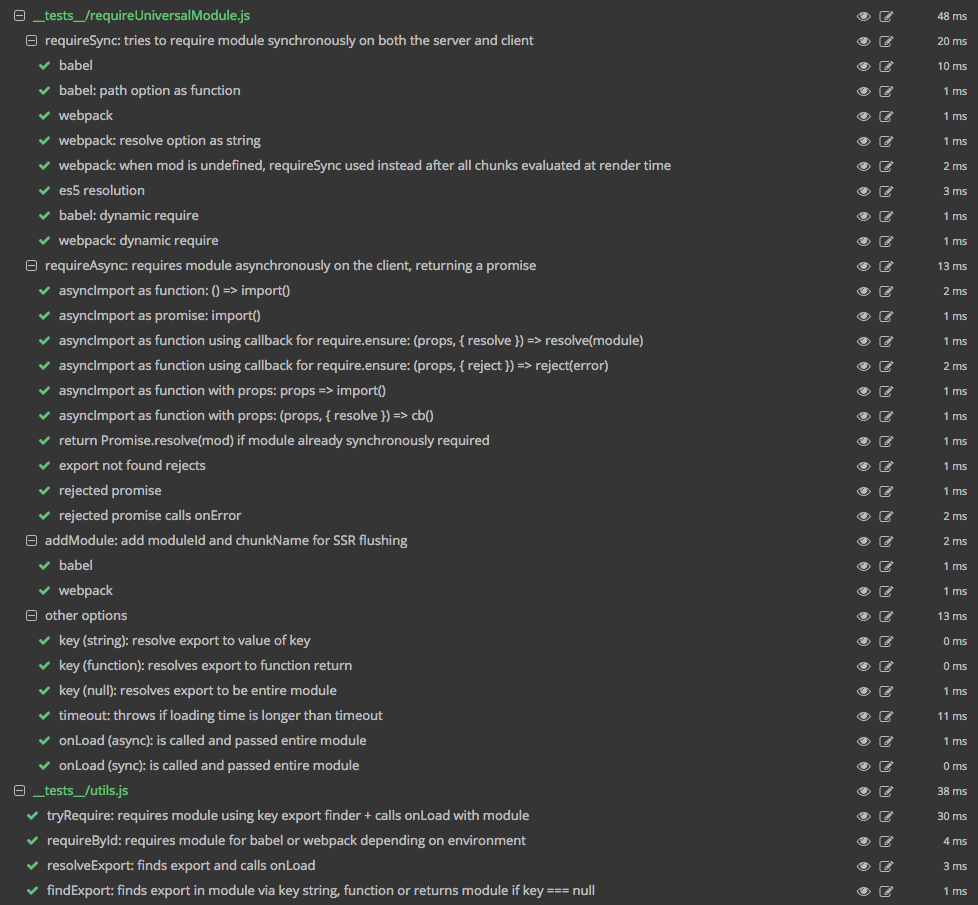

🍾🍾🍾 GIT CLONE 2.0 LOCAL DEMO 🚀🚀🚀
For "power users" the SPA is dead. If you're not universally rendering on the server you're doing it "wrong." You're losing money for you, your clients, your employers. All hail the Google god.
The real problem has been simultaneous SSR + Splitting. If you've ever attempted such, you know. This is a one-of-a-kind solution that brings it all together.
This is the final universal component for React you'll ever need, and it looks like this:
import universal from 'react-universal-component'
const UniversalComponent = universal(props => import(`./${props.page}`))
export default () =>
<div>
<UniversalComponent page='Foo' />
</div>It's made possible by our PR to webpack which built support for require.resolveWeak(`'./${page}`). Before it couldn't be dynamic--i.e. it supported one module, not a folder of modules.
You no longer need to create a hash of all your universal or loadable components. You can frictionlessly support multiple components in one HoC as if imports weren't static. This seamingly small thing--we predict--will lead to universal rendering finally becoming commonplace. It's what a universal component for React is supposed to be.
Of course, you also need webpack-flush-chunks to bring this together server-side. Ultimately that's the real foundation here and the most challenging part. Packages in the past like React Loadable did not address this aspect. They excelled at the SPA. In terms of universal rendering, they got you maybe 15% of the way by providing the module IDs rendered. There's a lot more than that.
Webpack Flush Chunks ensures you serve all the chunks rendered on the server to the client in style. To be clear, it's been impossible until now. This is the first general solution to do it, and still the only one. You must use it in combination with React Universal Component to fulfill the universal code splitting dream.
In the future both packages will be distilled into one product called universal-render--or "Universal" for short. The transition will be seamless. We're making this space as easy as possible for "power users" like yourself that prefer the frameworkless approach over the constraints of a framework like Next.js.
DEFINITION: "Universal Rendering" is simutlaneous SSR + Splitting, not trading one for the other.
That's probably because you were trapped in SPA land. If you didn't know how much of a pain in the ass universal rendering has been, check this quote from the React Router docs:
If you were already in the know, you're probably one of our first users, and we thank you for your support and feeling the essence of our mission. Thank god this is over!
yarn add react-universal-component
.babelrc:
{
"plugins": ["universal-import"]
}For Typescript or environments without Babel, just copy what babel-plugin-universal-import does.
Reactlandia Articles:
-
announcing-react-universal-component-2-and-babel-plugin-universal-import 🚀🚀🚀
-
how-to-use-webpack-magic-comments-with-react-universal-component
-
webpack-import-will-soon-fetch-js-and-css-heres-how-you-do-it-today
To be clear, you can get started with just the simple HoC shown at the top of the page, but to accomplish universal rendering, you will need to follow the directions in the webpack-flush-chunks package:
And if you want CSS chunks (which we highly recommend), you will need:
universal(asyncComponent, options)asyncComponent:
props => import(`./${props.page}`)import('./Foo')// doesn't need to be wrapped in a function when using the babel plugin!(props, cb) => require.ensure([], require => cb(null, require('./Foo')))
The first argument can be a function that returns a promise, a promise itself, or a function that takes a node-style callback. The most powerful and popular is a function that takes props as an argument.
Options (all are optional):
loading: LoadingComponent, -- default: a simple one is provided for youerror: ErrorComponent, -- default: a simple one is provided for youkey:'foo'||module => module.foo-- default:defaultexport in ES6 andmodule.exportsin ES5timeout:15000-- defaultonError: `(error, { isServer }) => handleError(error, isServer)onLoad:(module, { isSync, isServer }, props, context) => do(module, isSync, isServer, props, context)minDelay:0-- defaultalwaysDelay:false-- defaultloadingTransition:true-- default
In Depth:
All components can be classes/functions or elements (e.g:
Loadingor<Loading />)
-
loadingis the component class or function corresponding to your stateless component that displays while the primary import is loading. While testing out this package, you can leave it out as a simple default one is used. -
errorsimilarly is the component that displays if there are any errors that occur during your aynschronous import. While testing out this package, you can leave it out as a simple default one is used. -
keylets you specify the export from the module you want to be your component if it's notdefaultin ES6 ormodule.exportsin ES5. It can be a string corresponding to the export key, or a function that's passed the entire module and returns the export that will become the component. -
timeoutallows you to specify a maximum amount of time before theerrorcomponent is displayed. The default is 15 seconds. -
onErroris a callback called if async imports fail. It does not apply to sync requires. -
onLoadis a callback function that receives the entire module. It allows you to export and put to use things other than yourdefaultcomponent export, like reducers, sagas, etc. E.g:
onLoad: (module, info, props, context) => {
context.store.replaceReducer({ ...otherReducers, foo: module.fooReducer })
// if a route triggered component change, new reducers needs to reflect it
context.store.dispatch({ type: 'INIT_ACTION_FOR_ROUTE', payload: { param: props.param } })
}-
onLoad(continued) - As you can see we have thought of everything you might need to really do code-splitting right (we have real apps that use this stuff).onLoadis fired directly before the component is rendered so you can setup any reducers/etc it depends on. Unlike theonAfterprop, this option to theuniversalHOC is only fired the first time the module is received. Also note: it will fire on the server, so doif (!isServer)if you have to. But also keep in mind you will need to do things like replace reducers on both the server + client for the imported component that uses new reducers to render identically in both places. -
minDelayis essentially the minimum amount of time theloadingcomponent will always show for. It's good for enforcing silky smooth animations, such as during a 500ms sliding transition. It insures the re-render won't happen until the animation is complete. It's often a good idea to set this to something like 300ms even if you don't have a transition, just so the loading spinner shows for an appropriate amount of time without jank. -
alwaysDelayis a boolean you can set to true (default: false) to guarantee theminDelayis always used (i.e. even when components cached from previous imports and therefore synchronously and instantly required). This can be useful for guaranteeing animations operate as you want without having to wire up other components to perform the task. Note: this only applies to the client when yourUniversalComponentuses dynamic expressions to switch between multiple components. -
loadingTransitionwhen set tofalseallows you to keep showing the current component when theloadingcomponent would otherwise show during transitions from one component to the next.
Below is the most important thing on this page. It's a quick example of the connection between this package and webpack-flush-chunks:
import { clearChunks, flushChunkNames } from 'react-universal-component/server'
import flushChunks from 'webpack-flush-chunks'
import ReactDOM from 'react-dom/server'
export default function serverRender(req, res) => {
clearChunks()
const app = ReactDOM.renderToString(<App />)
const { js, styles, cssHash } = flushChunks(webpackStats, {
chunkNames: flushChunkNames()
})
res.send(`
<!doctype html>
<html>
<head>
${styles}
</head>
<body>
<div id="root">${app}</div>
${cssHash}
${js}
</body>
</html>
`)NOTE: this requires that the bundling and rendering happen within the same context. The module, react-universal-component/server holds a global cache of all the universal components that are rendered and makes them available via
flushChunkNames
If you build step and your render step are separate (i.e. using a static site generator like react-static) we can use a Provider type component to locate the components that should be included on the client. This is not the recommended use of locating chunk names and only should be used when absolutely necessary. It uses React's context functionality to pass the report function to react-universal-component.
import { ReportChunks } from 'react-universal-component'
import flushChunks from 'webpack-flush-chunks'
import ReactDOM from 'react-dom/server'
function renderToHtml () => {
let chunkNames = []
const appHtml =
ReactDOM.renderToString(
<ReportChunks report={chunkName => chunkNames.push(chunkName)}>
<App />
</ReportChunks>,
),
)
const { scripts } = flushChunks(webpackStats, {
chunkNames,
})
return appHtml
}You can preload the async component if there's a likelihood it will show soon:
import universal from 'react-universal-component'
const UniversalComponent = universal(import('./Foo'))
export default class MyComponent extends React.Component {
componentWillMount() {
UniversalComponent.preload()
}
render() {
return <div>{this.props.visible && <UniversalComponent />}</div>
}
}If your imported component has static methods like this:
export default class MyComponent extends React.Component {
static doSomething() {}
render() {}
}Then this will work:
const MyUniversalComponent = universal(import('./MyComponent'))
// render it
<MyUniversalComponent />
// call this only after you're sure it has loaded
MyUniversalComponent.doSomething()NOTE: for imports using dynamic expressions, conflicting methods will be overwritten by the current component
isLoading: booleanerror: new ErroronBefore:({ isMount, isSync, isServer }) => doSomething(isMount, isSync, isServer)onAfter:({ isMount, isSync, isServer }, Component) => doSomething(Component, isMount, etc)onError:error => handleError(error)
You can pass isLoading and error props to the resulting component returned from the universal HoC. This has the convenient benefit of allowing you to continue to show the same loading component (or trigger the same error component) that is shown while your async component loads AND while any data-fetching may be occuring in a parent HoC. That means less jank from unnecessary re-renders, and less work (DRY).
Here's an example using Apollo:
const UniversalUser = universal(import('./User'))
const User = ({ loading, error, user }) =>
<div>
<UniversalUser isLoading={loading} error={error} user={user} />
</div>
export default graphql(gql`
query CurrentUser {
user {
id
name
}
}
`, {
props: ({ ownProps, data: { loading, error, user } }) => ({
loading,
error,
user,
}),
})(User)If it's not clear, the same
loadingcomponent will show while both async aspects load, without flinching/re-rendering. And perhaps more importantly they will be run in parallel.
onBefore/After are callbacks called before and after the wrapped component loads/changes on both componentWillMount and componentWillReceiveProps. This enables you to display loading indicators elsewhere in the UI.
If the component is already cached or you're on the server, they will both be called back to back synchronously. They're both still called in this case for consistency. And they're both called before re-render to trigger the least amount of renders. Each receives an info object, giving you full flexibility in terms of deciding what to do. Here are the keys on it:
isMount(whether the component just mounted)isSync(whether the imported component is already available from previous usage and required synchronsouly)isServer(very rarely will you want to do stuff on the server; note: server will always be sync)
onAfter is also passed a second argument containing the imported Component, which you can use to do things like call its static methods.
const UniversalComponent = universal(props => import(`./props.page`))
const MyComponent = ({ dispatch, isLoading }) =>
<div>
{isLoading && <div>loading...</div>}
<UniversalComponent
page={props.page}
onBefore={({ isSync }) => !isSync && dispatch({ type: 'LOADING', true })}
onAfter={({ isSync }, Component) => !isSync && dispatch({ type: 'LOADING', false })}
/>
</div>Keep in mind if you call
setStatewithin these callbacks and they are called duringcomponentWillMount, thestatechange will have no effect for that render. This is because the component is already in the middle of being rendered within the parent on whichthis.setStatewill be called. You can use Redux to calldispatchand that will affect child components. However, it's best to use this primarily for setting up and tearing down loading state on the client, and nothing more. If you chose to use them on the server, make sure the client renders the same thing on first load or you will have checksum mismatches. One good thing is that if you usesetState, it in fact won't cause checksum mismatches since it won't be called on the server or the first render on the client. It will be called on an instant subsequent render on the client and helpfully display errors where it counts. The same won't apply withdispatchwhich can affect children components, and therefore could lead to rendering different things on each side.
onError is similar to the onError static option, except it operates at the component level. Therefore you can bind to this of the parent component and call this.setState() or this.props.dispatch(). Again, it's use case is for when you want to show error information elsewhere in the UI besides just the place that the universal component would otherwise render.
The reality is just having the <UniversalComponent /> as the only placeholder where you can show loading and error information is very limiting and not good enough for real apps. Hence these props.
flushChunkNames relies on renderToString's synchronous execution to keep track of dynamic chunks. This is the same strategy used by CSS-in-JS frameworks to extract critical CSS for first render.
To use these together, simply wrap the CSS library's callback with clearChunks() and flushChunkNames():
import { StyleSheetServer } from 'aphrodite'
import { clearChunks, flushChunkNames } from "react-universal-component/server"
import ReactDOM from 'react-dom/server'
clearChunks()
// similar for emotion, aphodite, glamor, glamorous
const { html, css} = StyleSheetServer.renderStatic(() => {
return ReactDOM.renderToString(app)
})
const chunkNames = flushChunkNames()
// res.send templateJust like CSS-in-JS libraries, this library is not compatible with asynchronous renderToString replacements, such as react-dom-stream. Using the two together will give unpredictable results!
Some data-fetching libraries require an additional step which walks the render tree (react-apollo, isomorphic-relay, react-tree-walker). These are compatible, as long as chunks are cleared after the collection step.
import { getDataFromTree } from "react-apollo"
import { StyleSheetServer } from 'aphrodite'
import { clearChunks, flushChunkNames } from "react-universal-component/server"
import ReactDOM from 'react-dom/server'
const app = (
<ApolloProvider client={client}>
<App />
</ApolloProvider>
)
// If clearChunks() is run here, getDataFromTree() can cause chunks to leak between requests.
getDataFromTree(app).then(() => {
const initialState = client.cache.extract()
// This is safe.
clearChunks()
const { html, css} = StyleSheetServer.renderStatic(() => {
return ReactDOM.renderToString(app)
})
const chunkNames = flushChunkNames()
// res.send template
})🍾🍾🍾 faceyspacey/universal-demo 🚀🚀🚀
git clone https://github.com/faceyspacey/universal-demo.git
cd universal-demo
yarn
yarn startWe use commitizen, so run npm run cm to make commits. A command-line form will appear, requiring you answer a few questions to automatically produce a nicely formatted commit. Releases, semantic version numbers, tags, changelogs and publishing to NPM will automatically be handled based on these commits thanks to semantic-release. Be good.
Reviewing a module's tests are a great way to get familiar with it. It's direct insight into the capabilities of the given module (if the tests are thorough). What's even better is a screenshot of the tests neatly organized and grouped (you know the whole "a picture says a thousand words" thing).
Below is a screenshot of this module's tests running in Wallaby ("An Integrated Continuous Testing Tool for JavaScript") which everyone in the React community should be using. It's fantastic and has taken my entire workflow to the next level. It re-runs your tests on every change along with comprehensive logging, bi-directional linking to your IDE, in-line code coverage indicators, and even snapshot comparisons + updates for Jest! I requestsed that feature by the way :). It's basically a substitute for live-coding that inspires you to test along your journey.
- redux-first-router. It's made to work perfectly with Universal. Together they comprise our "frameworkless" Redux-based approach to what Next.js does (splitting, SSR, prefetching, routing).






